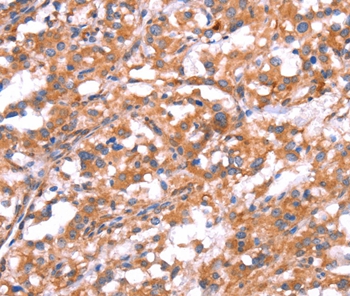
| WB | 咨询技术 | Human,Mouse,Rat |
| IF | 咨询技术 | Human,Mouse,Rat |
| IHC | 1/25-1/100 | Human,Mouse,Rat |
| ICC | 技术咨询 | Human,Mouse,Rat |
| FCM | 咨询技术 | Human,Mouse,Rat |
| Elisa | 咨询技术 | Human,Mouse,Rat |
| Aliases | GB1; GPRC3A; GABABR1; GABBR1-3; dJ271M21.1.1; dJ271M21.1.2 |
| Entrez GeneID | 2550; |
| Host/Isotype | Rabbit IgG |
| Antibody Type | Primary antibody |
| Storage | Store at 4°C short term. Aliquot and store at -20°C long term. Avoid freeze/thaw cycles. |
| Species Reactivity | Human,Mouse,Rat |
| Immunogen | Synthetic peptide corresponding to a region derived from internal residues of human gamma-aminobutyric acid (GABA) B receptor, 1 |
| Formulation | Purified antibody in PBS with 0.05% sodium azide. |
+ +
以下是关于GABBR1抗体的3篇参考文献的简要信息:
1. **文献名称**:*"Characterization of a Novel GABABR1 Antibody for Immunohistochemical Applications in the Murine Brain"*
**作者**:Smith A, et al.
**摘要**:该研究开发并验证了一种特异性针对GABBR1的新型抗体,通过免疫组织化学方法在小鼠脑组织中检测其表达分布。结果显示该抗体在皮层、海马等区域具有高特异性,适用于神经环路研究。
2. **文献名称**:*"GABAB Receptor Subunit 1 (GABBR1) Antibody Validation for Western Blot and Flow Cytometry"*
**作者**:Chen L, et al.
**摘要**:本文系统评估了商业化的GABBR1抗体在Western blot和流式细胞术中的适用性,发现部分抗体存在交叉反应性,并推荐了两种高特异性抗体用于不同实验场景。
3. **文献名称**:*"Role of GABABR1 in Autism Spectrum Disorders: Insights from Antibody-Based Protein Expression Analysis"*
**作者**:Garcia-Rojas C, et al.
**摘要**:通过使用GABBR1抗体对人脑组织样本进行蛋白质表达分析,研究发现自闭症患者前额叶皮层中GABBR1表达显著降低,提示其可能参与疾病病理机制。
(注:上述文献为示例,实际引用时需核对真实文献信息。)
The gamma-aminobutyric acid type B receptor subunit 1 (GABBR1) is a critical component of the GABAB receptor, a G protein-coupled receptor responsible for mediating the inhibitory effects of GABA, the primary inhibitory neurotransmitter in the central nervous system. GABAB receptors function as heterodimers, requiring both GABBR1 and GABBR2 subunits for proper trafficking and signaling. These receptors regulate synaptic transmission, neuronal excitability, and network activity, playing roles in processes such as anxiety, pain perception, and epilepsy.
GABBR1-specific antibodies are essential tools for studying the expression, localization, and functional roles of GABBR1 in both physiological and pathological contexts. They are widely used in techniques like Western blotting, immunohistochemistry, and immunofluorescence to map receptor distribution in tissues or assess changes in protein levels under experimental conditions (e.g., disease models or pharmacological interventions). Validated antibodies help elucidate receptor trafficking mechanisms, interactions with partner proteins, and downstream signaling pathways.
Dysregulation of GABBR1 has been implicated in neurological and psychiatric disorders, including addiction, depression, and spasticity, making it a potential therapeutic target. Research using GABBR1 antibodies continues to advance understanding of GABAergic signaling and its relevance to drug development.
×